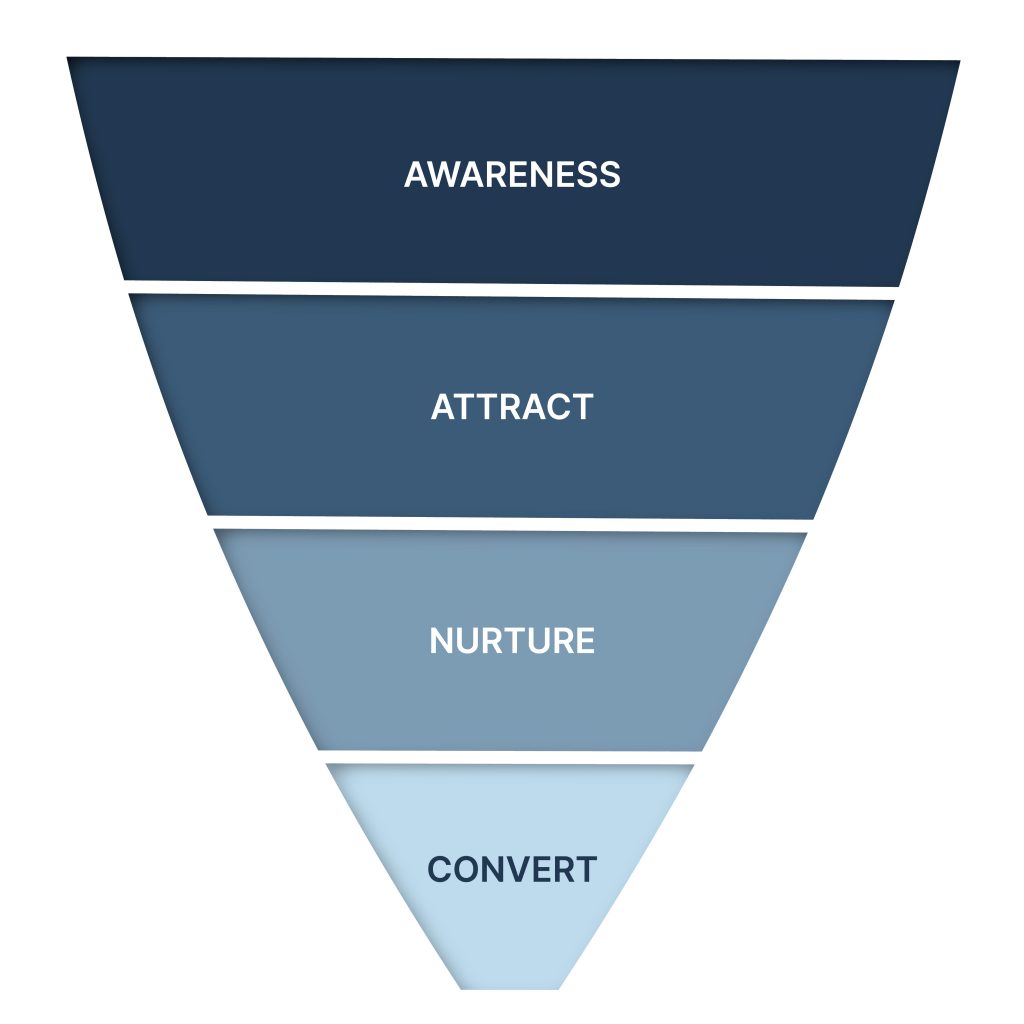If you’re trying to build a business, you need to be building an email list. One thing every business is always looking for is more leads, regardless of industry or niche. Using a marketing funnel is a great way to find leads! The best part is that marketing funnels are pretty much hands-off after you’ve set it up and optimized them.
Why do lead funnels work so well for getting leads? With cold calling or emailing, people are usually reluctant to respond. This type of sales is intrusive and makes people feel like they’re being sold to. You probably know that the best marketing does NOT feel salesy.
On the other hand, lead funnels give value to the leads first and foremost, making it much easier for people to give you their information. And once someone has entered the funnel, you can follow up with them in a natural way, e.g. “what did you think of the webinar?” or “did you have any questions for us after reading our guide?”. It makes an excellent jumping in point with a new lead.
Offering this value up-front makes people more likely to reciprocate and make a purchase decision, as well. This concept is called Reciprocity and it’s one of the 8 Psychological Principles of Marketing. It feels like a fair trade for them; they get value from your company and they give you their email in exchange.
In marketing funnels, we call the free offering a lead magnet. It can take many forms; an e-book, white paper, video, webinar, etc. You absolutely must keep your lead magnet related to your main offer; there’s no point attracting people who aren’t interested in purchasing from you. The more compelling your lead magnet is, the less they’ll care that they gave you their information.
We’ve established what lead funnels are and why they work, but how do you set one up? We’ve identified 3 key steps:
- Funnel Set-Up
- Test and Analyze
- Focus on what works
But before we get into these 3 steps, let’s discuss how the different phases a lead goes through in a funnel.
How A Funnel Works (4 Phases)

Awareness Phase
Marketing funnels begin in the awareness phase, where you are paying for ads or using free outlets like Facebook groups to share your lead magnet. In this phase, you’ll want to get your name in front of a targeted audience as much as possible. Get people aware of your business. Make sure they’re seeing your funnel offering as much as possible. Seeing it once isn’t enough.
People don’t always click right away, it can take a few times before they’ll act. There’s a concept in marketing called the Rule of 7, meaning a prospect needs to “hear” your message at least 7 times before they’ll make a purchase.
The important part here is having the right messaging and speaking to your audience in an impactful way. We’ll get more into that below.
Attraction Phase
In the attraction phase, a lead is interested enough to click on your content. You’ve attracted them to take action! They give you their email address in exchange.
- You get their contact information
- They download the lead generator
- They’re added to your email list
- Follow up
The lead magnet they downloaded makes for the perfect reason to follow up with them! It feels natural to ask them what they thought of the e-book, webinar, etc. instead of just sending a sales email to introduce your company.
Nurturing Phase
In the nurturing phase, you should have several predetermined emails you’re sending to them. Ask them what they thought of the download and send them related content they may enjoy. Going to salesy at first will make people opt-out lickety split. Avoid pushy marketing/sales tactics.
Set up a series of 3-4 emails spread out by several days up to 2 weeks. Here are 15 email marketing tips. After they complete the series of emails, add them to your normal marketing list where you send monthly or weekly outreaches and more salesy content.
After completing the initial automatinon, they may have questions but likely won’t want to put in the effort of finding your company’s contact info. Make it easy for them. Have your sales team reach out, giving them a direct and friendly way to contact your company.
Conversion Phase
The conversion phase begins when a prospect becomes a paying customer. Sometimes they’ll move into this phase right away, while others may take a while to trust you or see the value from your product.
After someone converts, the nurturing doesn’t end, but the way you nurture them may change. For example, if you’re a technology firm promoting your software, you may start including “how-to” tutorials or training webinars for using the technology.
The details of each phase are not set in stone and you can certainly modify them in the way that works best for your company!
The 3 Steps to Setting Up Your Successful Funnel
Step 1. Funnel Set-Up
There are tons of different software available to set up marketing funnels. What you use depends on your technical ability. You could set it up directly on your website (WordPress works well for this), which does require some technical knowledge. Or click here to read about other easy-to-use funnel software you can use right out of the box.
After picking software, you’re going to start off by designing your funnel as best you can. Use benefit-focused language, making it clear to viewers what the outcome will be if they opt in.
For example…
- Don’t just say, “Download our e-book about ESG principles.”
- Do say, “Download our e-book to learn how you can implement ESG operationally at your firm.”
The difference is one focuses on what it is, and the other gives them a specific outcome. We recommend including a bulleted list of several outcomes.
You will need to prepare each of these items thoughtfully:
- Your value offering (e-book, guide, etc.)
- Social media images
- Written content: (1) a hook and (2) a description. The hook is the thing that gets their attention, and a description should get them even more excited. The description should help them visualize the positive outcome.
- “Squeeze” or landing page with a bulleted list of outcomes/benefits and a form.
- ‘Thank you’ email when they fill out the form
- Include the download link in the email or automatically redirect them
- Set of several automated nurturing emails. (Many click funnel and email marketing software will give you email automation abilities.)
What kind of lead magnet should you use?
E-books are by far the most common type of lead generator, and they give pretty average results. Why? Because ‘learning’ is a painful word for many. Sitting down and reading an e-book is a laborious process and seems daunting. It means they have to learn and do it themselves.
On the other hand, guides that give people quick fixes are going to be more successful. For example, if I say “learn how to write stellar sales emails so you can grow your business,” that implies they have to actually do the work and learn. But if I say, “here’s 6 ready-made sales email templates you can start using right away,” that makes it so easy for them to get started. Seems less daunting, right?
The most successful lead generators are things like:
- Checklists
- Cheat sheets
- Proven processes
- Things they can copy/paste and use right away
Step 2. Test and Analyze
Once you’ve set up the funnel, it’s time to test it out. Run it on a smaller scale to start. If you’re paying for ads to promote it, don’t go headfirst. Start with $10/day or something else that seems doable.
Another best practice is to set up an A/B test. Duplicate your funnel and use different ads or landing pages for each campaign. Try to only change one thing between versions A and B so you understand why one might do better than the other. Continue to test in phases of 1-3 weeks, adjusting to optimize it.

Step 3. Focus on What Works!
What really makes these 3 steps successful is the adapting you’re going to do. You need to get a good understanding of what is and isn’t working. It’s an intensive process and takes plenty of analyzing, but you’ll be much better off for it.
So in this step, focus only on what works and scrap the rest. If one nurturing email is performing poorly — let’s say the click-through rates are terrible compared to the other emails — change it and see how it does now. Learn from what does well or fails.
Apply this concept to your entire funnel. Analyze each stage of the journey your leads will take. After the marketing funnel is consistently converting leads through each step of the process, it’s time to step back and watch the growth happen! You’ll have yourself a killer lead funnel.
As a final note, you should still re-visit your funnel every so often to see if it’s still performing just as well. Changes in your industry can affect consumer behavior and create a necessity to adapt your marketing message.






